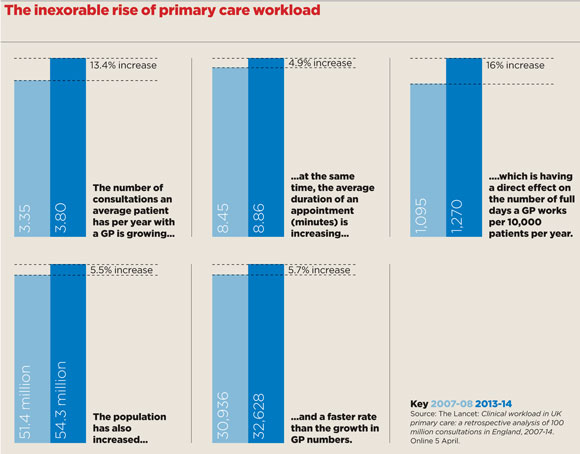The inexorable rise of GP workload

Primary care in England could be reaching ‘saturation point’, with patients seeing GPs more often and for longer, while workforce numbers struggle to keep pace, according to a new study published in The Lancet.
The largest-ever analysis of GP and nurse consultations shows general practice workload increased by 16% between 2007 and 2014, while patients are seeing their GP 13% more often.
While overall workload has increased, the number of GPs has fallen from 60.9 to 60.6 per 100,000 patients.
The authors of the landmark study said GPs had been warning for years that workload had been increasing and, ‘for the first time, we are able to provide objective data that this is indeed the case’.
The study covered more than 100 million GP and nurse consultations at 398 general practices in England.
It concluded: ‘Our findings show a substantial increase in practice consultation rates, average consultation duration, and total patient-facing clinical workload in English general practice. These results suggest that English primary care as currently delivered could be reaching saturation point.’
They added that ‘indirect activities and professional duties’ not covered by the research had also increased.
Clear evidence
RCGP chair Dr Maureen Baker said: ‘This important research confirms what the college has been saying for years. GPs and our teams are making more consultations than ever before, and our patients are living longer and with multiple, long-term conditions, meaning that our workload is growing in complexity as well as volume.’
GPC deputy chair Dr Richard Vautrey said: ‘This study provides clear evidence to support what every GP and patient knows: GP practices are working harder than ever, but are struggling to provide even basic levels of care.’
A Department of Health spokesperson said: ‘With an ageing population, GPs are seeing more patients with complex health conditions than ever before. That is why we are investing in safer seven-day services and boosting the primary care workforce.’

primary care workload box 580x454px
Pulse October survey
Take our July 2025 survey to potentially win £1.000 worth of tokens











